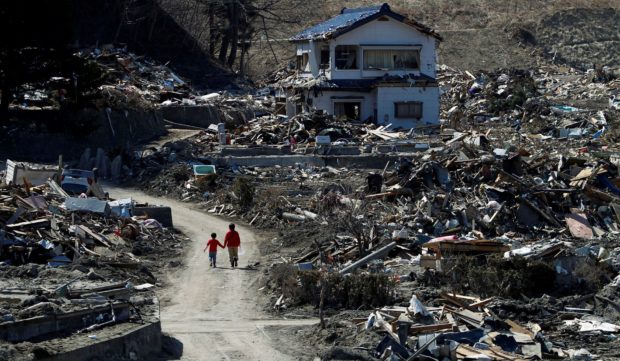Radar to reveal growth of roots in Japan’s tsunami-resistant forests

People walk at an area that was damaged by the March 11 earthquake and tsunami in Miyako, Iwate prefecture, April 5, 2011 | PHOTO: Reuters – Toru Hanai
TOKYO — A team of researchers will study the roots of disaster-prevention buffer forests that were planted on embankments after the 2011 Great East Japan Earthquake, as poor drainage may be hindering their growth.
Researchers from the Forestry and Forest Products Research Institute in Tsukuba, Ibaraki Prefecture, Nagoya University and other institutions plan to use radar in the survey, which will be launched in fiscal 2022 starting in April. They will compile proposals based on the results by the end of fiscal 2025.
According to the Forestry Agency, the tsunami triggered by the earthquake swept away or damaged about 1,700 hectares of buffer forests along the Pacific coastlines of six prefectures from Aomori to Chiba.
The government has been working to regenerate coastal forests as they are effective in lessening the power of tsunami, delaying their arrival in inland areas and keeping drifting materials to the coast.
By the end of March last year, trees had been planted across about 690 hectares to create forests around places including Sendai Bay, Ishinomaki in Miyagi Prefecture, and the beach in Misawa, Aomori Prefecture. In some areas, trees have grown as high as 4 or 5 meters.
Article continues after this advertisementTrees were planted on elevated land to allow their roots to stretch 2 to 3 meters down to the layer of groundwater.
Article continues after this advertisementHowever, it can become difficult for trees to root properly when there is poor drainage, which happens if the soil is harder than expected due to heavy machinery use and other reasons. Underdeveloped roots can make trees fall over in a large tsunami, which can then flow to urban areas and cause greater damage.
The researchers will send radar waves toward several points underground in the forests in the vicinity of Sendai Bay and analyze the reflected waves to examine the shape and tension of roots. They will then study appropriate tree-planting methods for creating the forests.
“We want to propose ways to create tsunami-resistant forests,” said Hironori Noguchi, head of the institute’s Meteorological Forest Damage and Buffer Forest Laboratory.
RELATED STORIES
Japan quake brings back memories of deadly 2011 tsunami
Phivolcs: No tsunami threat to PH after magnitude 7.3 Japan earthquake
7.1-magnitude quake off east Japan, no tsunami alert